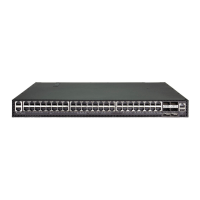C
HAPTER
36
| Class of Service Commands
Priority Commands (Layer 2)
– 1162 –
EXAMPLE
The following example shows how to assign round-robin weights of 1 - 4 to
the CoS priority queues 0 - 3.
Console(config)#queue weight 1 2 3 4
Console(config)#
RELATED COMMANDS
queue mode (1160)
show queue weight (1163)
switchport
priority default
This command sets a priority for incoming untagged frames. Use the no
form to restore the default value.
SYNTAX
switchport priority default default-priority-id
no switchport priority default
default-priority-id - The priority number for untagged ingress traffic.
The priority is a number from 0 to 7. Seven is the highest priority.
DEFAULT SETTING
The priority is not set, and the default value for untagged frames received
on the interface is zero.
COMMAND MODE
Interface Configuration (Ethernet, Port Channel)
COMMAND USAGE
◆ The precedence for priority mapping is IP DSCP, and then default
switchport priority.
◆ The default priority applies for an untagged frame received on a port
set to accept all frame types (i.e, receives both untagged and tagged
frames). This priority does not apply to IEEE 802.1Q VLAN tagged
frames. If the incoming frame is an IEEE 802.1Q VLAN tagged frame,
the IEEE 802.1p User Priority bits will be used.
◆ The switch provides four priority queues for each port. It can be
configured to use strict priority queuing, Weighted Round Robin (WRR),
or a combination of strict and weighted queuing using the queue mode
command. Inbound frames that do not have VLAN tags are tagged with
the input port's default ingress user priority, and then placed in the
appropriate priority queue at the output port. The default priority for all
ingress ports is zero. Therefore, any inbound frames that do not have
priority tags will be placed in queue 1 of the output port. (Note that if
the output port is an untagged member of the associated VLAN, these
frames are stripped of all VLAN tags prior to transmission.)

